THURSDAY
OCTOBER 31 - 2013
Nore
Barn
11:30 - I did my daily
check of the small stream at Nore Barn about 3 hours
after high water. The only birds in the stream were 8
Mute Swans. The family with one cygnet from Peter Pond
was also present. So the mystery of the missing
Spotted Redshank continues. Despite my daily visits,
it is now 9 days since I last saw the bird here on Oct
22 and another 11 days since my first sighting of the
season on Oct 11. Clearly, the bird has not settled
into its usual feeding routine in visiting the stream
around high water. It may well well have found a
better feeding area, though I would be surprised if it
had completely abandoned the Nore Barn stream.
Black-tailed Godwits:
65 in Nore Barn Creek including six regulars G+WR,
L+LL, R+LG, W+WN, WO+LW flag and ROL+RLR.
Nutbourne
Bay
12:15 - I drove over
to have a look at the stream in Nutbourne Bay just in
case the Spotted Redshank had gone there. But, like
Nore Barn, there were no birds in the stream, not even
the regular colour-ringed Greenshank GY+GY. 47
Black-tailed Godwits and about 100 Dunlin were feeding
on the shore. I checked all the Godwits but there were
no colour-rings. Interestingly, I noticed a lot of
'spurting' as the birds were feeding in the shallow
water.
Brook
Meadow
Malcolm Phillips was
back on Brook Meadow today looking for Water
Voles again and this time he was successful. He
saw this one swimming in the river near the sluice
gate.
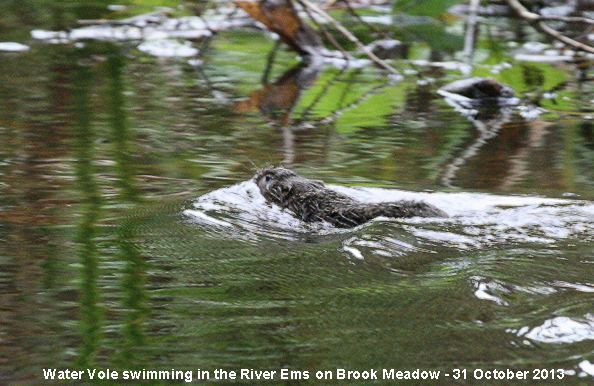
WEDNESDAY
OCTOBER 30 - 2013
EMSWORTH
Nore
Barn - 11:00 -
12:00 - Tide falling from high water at 08:19. Mute
Swan family with one cygnet, probably from the Peter
Pond nest. Black-tailed Godwits - 98 gathered
in the Nore Barn channel as I watched. I only checked
a few of them for colour-rings and found two regulars:
W+WN and WO+LW flag.
On the western
mudflats - 14 Shelduck and 56 Brent
Geese - with 3 juveniles in broods of 2 and 1.
Here
are two Brent juveniles from one family showing their
white wing bars
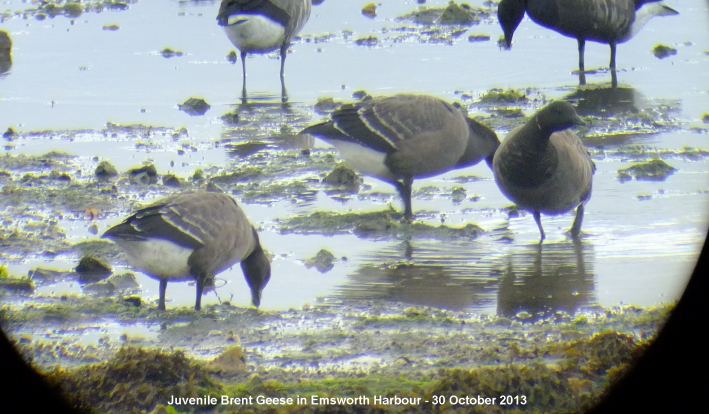
While walking along
the path south of Nore Barn Woods I spotted this
bright Red Admiral basking in the sunshine on a
notice asking people to watch out for dogs attacking
swans at Nore Barn.

Emsworth
Millpond
The Mute Swan
family with one cygnet was on the millpond. There
were three other swans on the pond and the resident
pair did chase the intruders with wings raised, but
not with serious intent from what I could see.
Here
is the once scraggy cygnet from the 'litter nest'
which now looks very healthy

Two Cormorants
were fishing in the millpond along with a Little
Grebe.

Brook
Meadow
Malcolm Phillips spent
3 hours on the meadow today. He looked in vain for a
Water Vole. However, he did get this excellent image
of a Little Egret perched in a Crack Willow
tree.
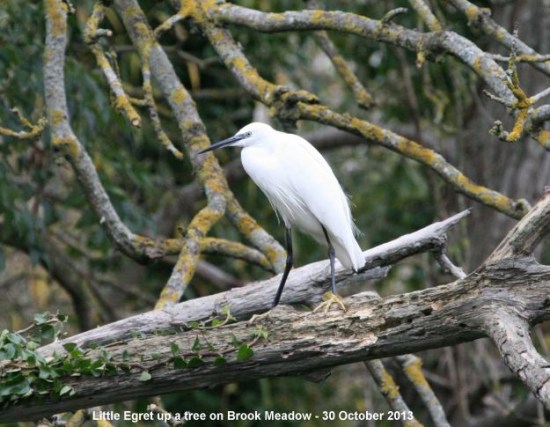
Malcolm also captured
this delightful Long-tailed Tit in the act of
singing.
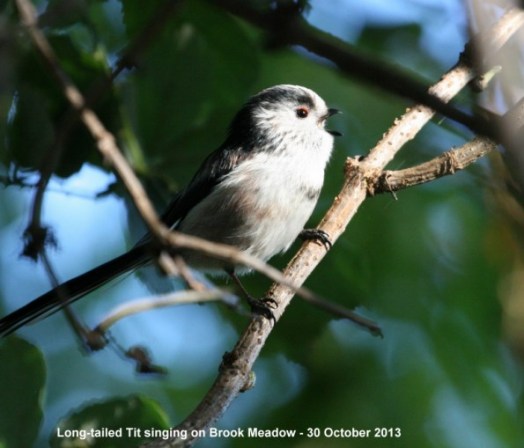
As always at this time
of the year and in warm weather, the banks of
Michaelmas Daisies attract a variety of insects
seeking a good nectar source. Malcolm saw Red Admiral
and this Comma.

TUESDAY
OCTOBER 29 - 2013
Nore
Barn
09:30 - 10:00 - About
2 hours after high water. The Black-tailed Godwits
gradually arrived on the emerging mudflats in Nore
Barn Creek building up to 54 birds by the time I left.
I noted the following colour-ringed birds, all
regulars : G+WR, R+OG, WO+LW flag. The only birds in
the stream were a Greenshank and a Grey Plover which
has been regular here for the past few days. Still no
sign of the Spotted Redshank. Where has it got to?
Will it come back?
Emsworth
Millpond
The pond was still
empty of water, but for a central channel from the
Westbrook Stream. The regular nesting pair were in the
stream together with their cygnet which was absent
yesterday when I think I saw it at Nore Barn. It was
looking very good and healthy and is almost certainly
now flying well. There were 5 other swans on the
millpond - not yet driven off by the resident pair.
MONDAY
OCTOBER 28 - 2013
EMSWORTH
Brook
Meadow - storm damage
There was surprisingly
little damage following last night's storm which was
certainly of much less magnitude than the storm of
1987 which brought down thousands of trees everywhere
along the south coast. A large willow branch had split
off just north of the north bridge over the Seagull
Lane patch, but was not blocking anything.
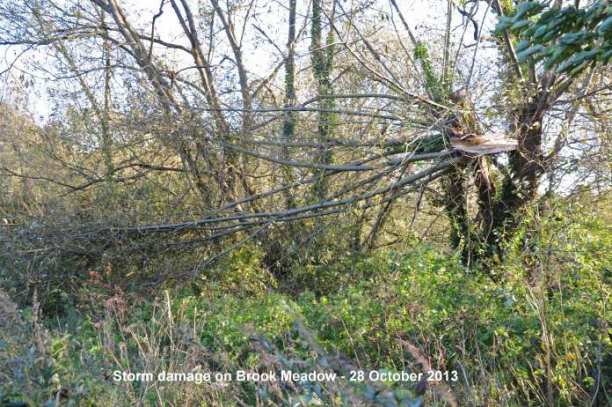
The inner fence has
been removed from the kissing gate at the Seagull Lane
entrance and is currently leaning on a lamppost on the
north side of Seagull Lane. The removal of the fence
by the gate was so neat I thought it had been planned.
It does make it easier to negotiate with bikes. Maybe
that was the reason?

Emsworth
Millpond
An adult Great
Black-backed Gull along with a juvenile was on the
town millpond this morning. They are probably birds
from the Slipper Millpond nest this spring.
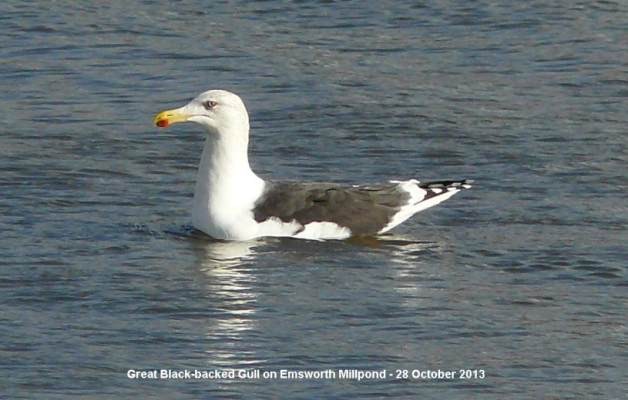
Just two Mute Swans
were on the pond, probably the pair that nested
here. They are clearly still doing a good job in
deterring the rest of the swan flock from returning,
apart from the lone swan that sits on the grass verge
of Bridgefoot Path. I found what is probably the
cygnet from this nest at Nore Barn later - see below.
A Little Grebe
was fishing in the pond, the first I have seen there
this season.
Nore
Barn
15:00 - 16:00. Tide
rising to high water at 18:00. The conditions were
better than I expected after last night's storm,
though I did get caught in a torrential downpour. The
sun was very bright at times, but created a nice light
as it went down in the west. A good variety and number
of birds gathered in the Nore Barn area as the tide
rose.
Brent Geese: 25
adults and 6 juveniles in broods of 3, 2, 1.
Shelduck: 11 - the first I have seen for a
while. Wigeon: 168, Teal: 14
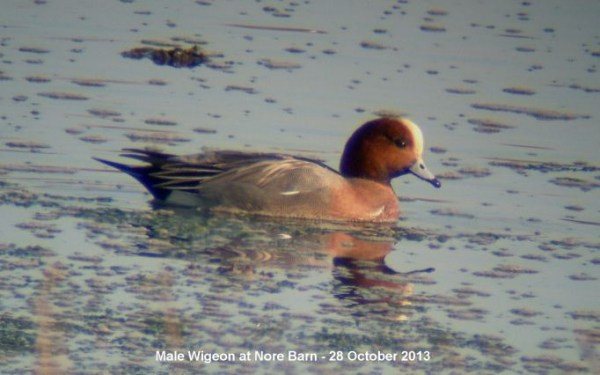
In the stream
at 16:00 were Greenshank, Common Redshank, adult
Black-tailed Godwit and Black-headed Gull, but no sign
of the Spotted Redshank. I have had only two sightings
of the Spotted Redshank in the stream this season,
11-Oct and 22-Oct. The early season sightings were
very irregular last year, so I hope this is similar to
that and does not indicate an abandonment of the
stream.
Mute Swans: 16
including two cygnets. There has been a single cygnet
with parents at Nore Barn for a couple of weeks, which
I assume are from the Peter Pond nest. The other
cygnet was alone and my guess is that it is the
abandoned offspring of the town millpond pair which
were both on the millpond when I passed by this
morning. Clearly, this pair are still defending the
pond as their territory from intruding swans.
Black-tailed
Godwits: 150+ with 10 colour-ringed birds,
including a first for Emsworth :
G+BG - Emsworth regular. 4th sighting this season.
G+WR - Emsworth regular. 7th sighting this season.
L+LL - Emsworth regular. 6th sighting this season.
R+GY - First sighting in Emsworth. My only other
sighting was on 09-Jul-09 at Farlington.
R+LG - Second sighting in Emsworth this season. New
one.
R+OG - Second sighting in Emsworth this season. New
one.
R+YN - Second sighting in Emsworth this season.
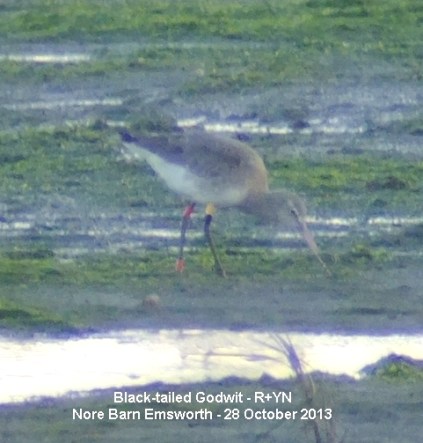
W+WN - Second sighting
in Emsworth this season.
OY+LR - Emsworth regular. 2nd sighting this
season.
WO+LW flag - Emsworth regular. 3rd sighting this
season.
Other birds in
the area: Grey Plover, Oystercatcher, Curlew,
Redshank.
SUNDAY
OCTOBER 27 - 2013
Insects
on Hogweed
Walking through Brook
Meadow this morning I noticed several insects feeding
on the open flower heads of Hogweed.
The photo on the left
shows a very familiar hoverfly Helophilus
pendulus which is fairly easy to identify from
the longitudinal stripes on its thorax - also known as
'The Footballer' for its striped 'shirt'.
The photo on the right
shows very bristly black fly with red bases on its
wings. My very tentative guess is a Tachinid Fly whose
larvae are internal parasites of caterpillars and
other young insects. See . . . http://www.nadsdiptera.org/Tach/Gen/tachintr.htm
Sparrowhawk
in garden
Patrick Murphy has had
a Sparrowhawk visiting his garden in North Emsworth a
couple of times this week. Today it landed on a bird
feeder stand about 8 ft the other side of the window
giving Patrick a good photo opportunity. From the
rufous barred underparts this bird looks like a male.
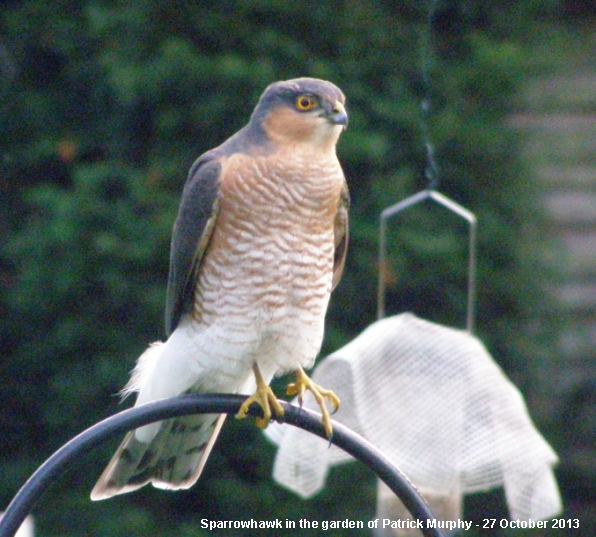
Blashford
Lakes
Heather Mills reports
on yesterday's walk by the Havant Wildlife Group. The
group were delighted to see a Great White Egret
close to in their first hide. The yellow colour of
the bill (dark in the breeding season) and pure white
plumage showed up well. It soon got chased off by the
local Grey Heron.
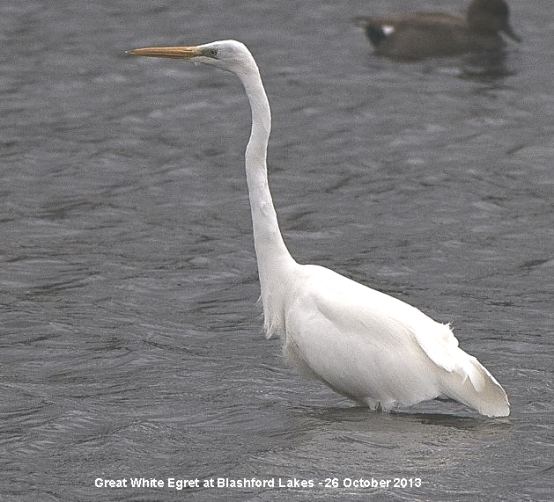
Heather's full report
is on the 2013 reports web page at . . .
Havant
Wildlife Group
THURSDAY
OCTOBER 24 - 2013
EMSWORTH
HARBOUR
12:30 - 13:30 Tide
rising to high water at 15:20. The tide was already
filling up the western harbour by the time I arrived.
Brent
Geese - were
up on yesterday with 48 on the western mudflats
including 10 juveniles in families of 4, 3, 2 and 1.
The families with 3 and 2 juveniles were new from
yesterday. My current percentage of juveniles to
adults is approaching 20%, though I am sure some of
the juveniles have been counted more than once.
Black-tailed
Godwits -
These were also well up on yesterday with a total of
136 in the western harbour, including Nore Barn. In
general, they were too far away, or in water, for me
to check for colour-rings. However, I did find WO+LW
flag - the 3rd sighting in Emsworth this season.
Buzzards
- Two Buzzards
flew out of Nore Barn Woods making quite a racket and
flew off together towards Warblington. Nest site
prospecting?
Nore
Barn stream -
The only birds in the stream today were 6 Mute Swans.
No sign of any shanks, godwits or egrets.
BROOK
MEADOW
Malcolm Phillips is
back from his hols and had a walk around the meadow
today. He had a Red Admiral feeding on the bank of
Michaelmas Daisies. He also got this unusual
perspective on a bright Comma. It should soon be
looking for somewhere to hibernate for the winter.
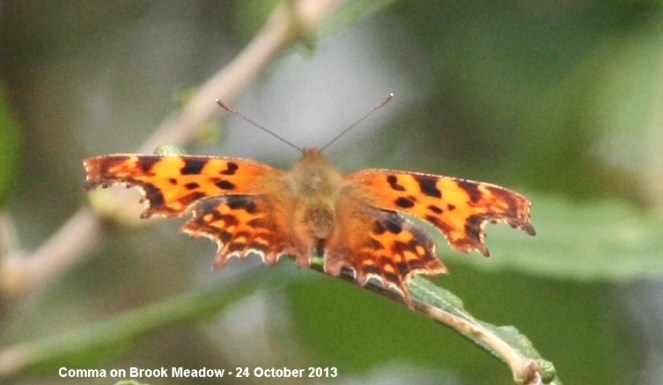
WEDNESDAY
OCTOBER 23 - 2013
EMSWORTH
HARBOUR
11:30 - 12:30 - Tide
rising to high water at 14:45. An incredibly strong SW
wind was blowing into my face while cycling along
Western Parade towards Nore Barn.
Black-tailed
Godwits
104 were feeding and
roosting on the edge of the rising tide at Nore Barn
with some handsome male Wigeon mixed in with them.
They included 9 colour-ringed birds. Four regular
Emsworth godwits. The rest first timers.
G+BG - Regular in
Emsworth since Sep 2010. 3rd sighting this season.
G+WR - Regular in
Emsworth since Jul 2009. 6th sighting this season.
WO+LW flag - Regular
in Emsworth since Nov 2010. 2nd sighting here this
season.
ROL+RLR - Regular in
Emsworth since Oct 2009. 4th sighting here this
season.
O+OG - First sighting
in Emsworth since Jan 2006. Seems to have been a
Fishbourne - Bosham regular since then.
B+RN - This is my
first ever record of this bird.
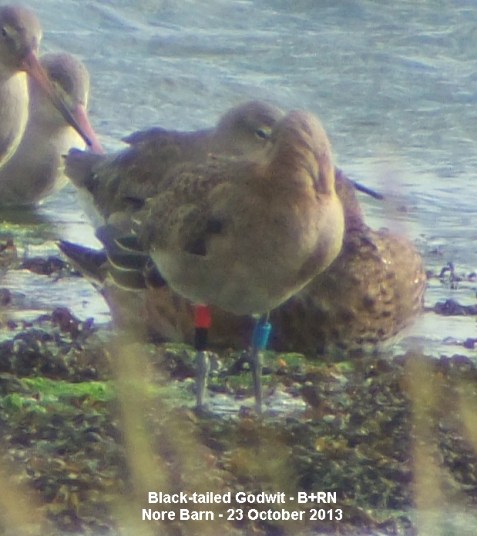
R+LG - This is my
first ever record of this bird. It could possibly be
O+LG.
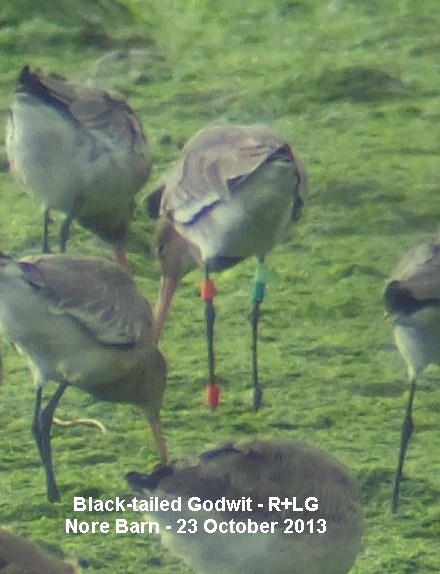
R+OG - Previously seen
by Peter Milinets-Raby at Warblington on 17-Oct-13.
This is the first sighting in Emsworth.
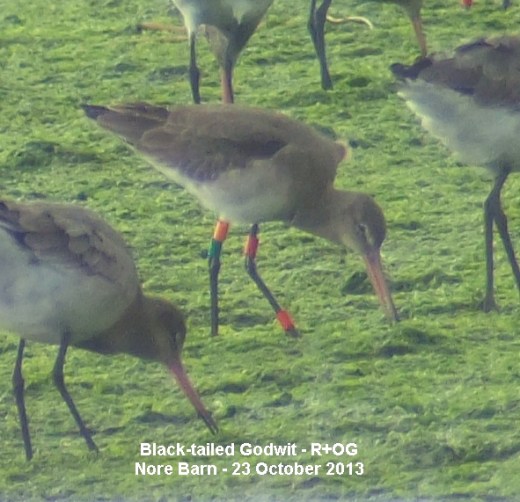
R+OY - This is my
first ever record of this bird.
For
all the Black-tailed Godwit news in Emsworth go to . .
.
Black-tailed
Godwits
OTHER
BIRDS
Brent Geese -
26 were on the western mudflats with 5 juveniles in
broods of 4 and 1. In the Nore Barn stream were one
Little Egret and one Greenshank. 12 Mute Swans. No
sign of the Spotted Redshank today.
CORRECTION
TO PSYLLID BUG
I sent a copy of the
photo of the insect I photographed on Oct 21 on
Hogweed on Brook Meadow to Bryan Pinchen for his
opinion.
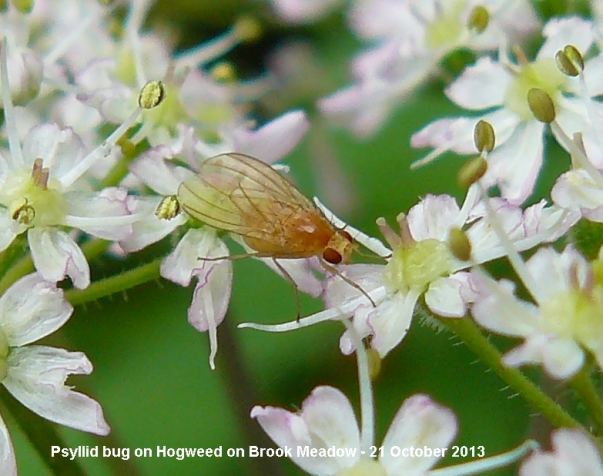
Bryan said the insect
was not a Psyllid bug, but was a true fly (diptera). A
Psyllid bug would have the wings held roof-wise or
tent-like over the abdomen, not flat across it like
this insect. He thought it may be one of the
Drosophlildae or Agromyzidae, but the wing venation
was not clear enough on the photo to be certain.
Images of
Drosophlildae on Google have the same large red eyes
as the insect in my photo with wings held flat over
the abdomen, but there are hundreds of them, so that
is as far as I can go. See . . . https://www.google.co.uk/search?q=drosophilidae&safe=off&tbm=isch&tbo=u&source=univ&sa=X&ei=xZBnUqilNqOd0QW7yIDIDw&sqi=2&ved=0CDcQsAQ&biw=1280&bih=815
TUESDAY
OCTOBER 22 - 2013
NORE
BARN
11:00 -12:00 - Tide
rising to high water at 14:00. I spent an hour at Nore
Barn with intermittent rain and strong wind blowing
from the SW. Black-tailed Godwits - 52 arrived
to feed on the mudflats, with three colour-ringed
birds: RLR+ROL - Kent ringed. 3rd sighting this
season. L+LL - 5th sighting this season. WO+LW flag -
Ringed as a chick in north Iceland on 13th July 2010
by Ruth Croger and Pete Potts. A regular in Emsworth
over the past 3 winters. First sighting this
season.
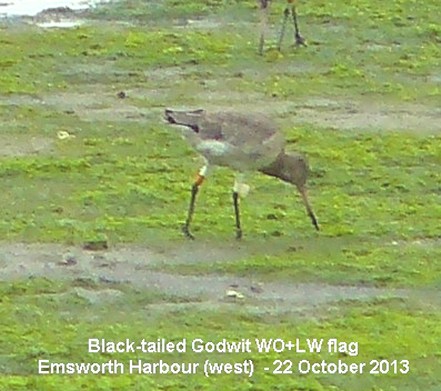
Two Greenshank
and a Little Egret at the top of the Nore Barn
Woods channel. One Greenshank was colour-ringed -
LG+YY. This was my frst ever sighting of this bird -
probably one of those ringed at Thorney Island earlier
this month.
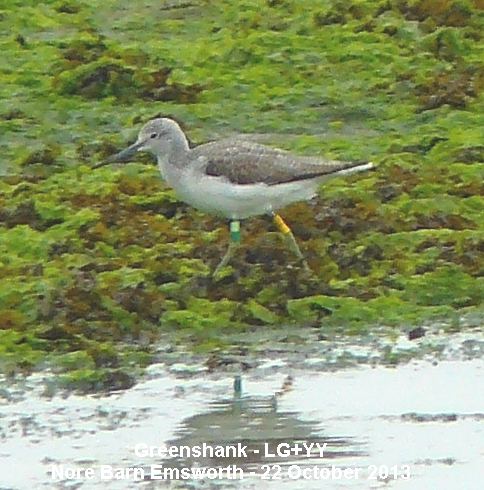
The Spotted
Redshank was back in the Nore Barn stream - first
sighting since 11-Oct. It was feeding with
Greenshank.
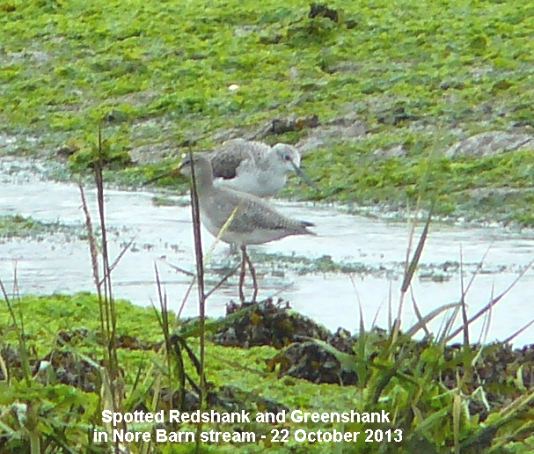
Common Redshank,
Little Egret and juvenile Black-tailed Godwit were
also in the stream. Six Mute Swans were in the lower
stream along with 9 Brent Geese and 100+ Wigeon and
Teal.
OTHER
NEWS
Barry Collins caught a
Convolvulus Hawk-moth in his garden last night.
This is a large species, with a wingspan of over 10cm.
It is a migrant in Britain, appearing sometimes in
fairly good numbers, most often seen in late summer
and autumn, usually with influxes of other migrant
species, when it turns up in light traps and feeding
at garden flowers, especially those of the tobacco
plant (Nicotiana).
MONDAY
OCTOBER 21 - 2013
WAYSIDES
NEWS
I did a tour around
the Emsworth waysides this afternoon. It was great to
see that all of the Waysides have been cut - courtesy
of Richard Denman and his team at Havant Borough
Coucil. The team have done a good job and all of the
Waysides. The Friends of Emsworth Waysides are very
grateful for the ongoing support from the Borough.
Here is the Washington Road path where the Greater
Burdock used to stand tall. They should be back next
year.

Here are the large
berries on the American Hawthorn - Broad-leaved
Cockspur Thorn - on the Westbourne Open Space. Much
smaller berries on the native Hawthorn growing nearby.
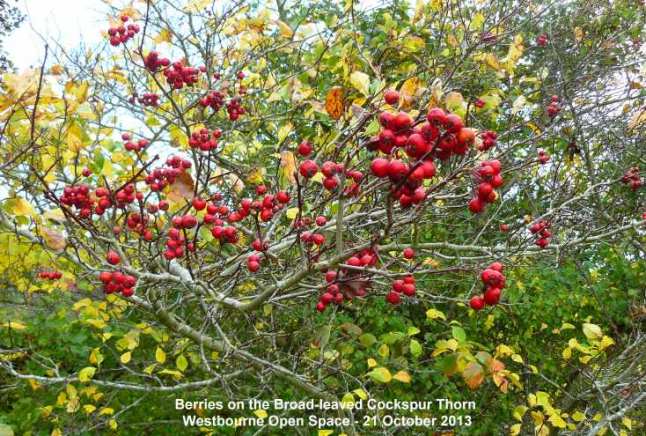
INSECTS
Walking through Brook
Meadow this morning I noticed a number of insects
feeding on the flowering umbels of Hogweed along the
main river path. These included drone flies and hover
flies (Scaeva pyrastri)
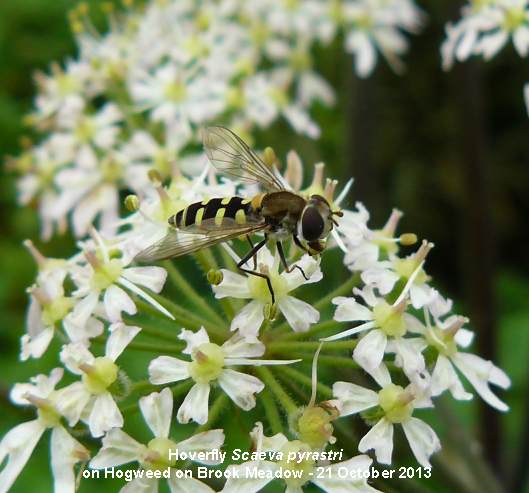
Psyllid
bug ??
I also noticed what
looked like a Psyllid bug with gingery wings and big
red eyes . Psyllid Bugs are small
homopteran bugs, which are often called jumping plant
lice from their ability to leap well with the hind
legs. From the British Bugs web site the best match
for my photo was the Boxwood Psyllid - Psylla
buxi. This is said to be widespread in Britain,
but only on box trees. So, what was it doing feeding
on Hogweed flowers on Brook Meadow where there are no
Box trees to my knowledge.

Correction
- I sent a
copy of the photo to Bryan Pinchen for his opinion.
Bryan said the insect was not a Psyllid bug, but was a
true fly (diptera). A Psyllid bug would have the wings
held roof-wise or tent-like over the abdomen, not flat
across it like this insect. He thought it may be one
of the Drosophlildae or Agromyzidae, but the wing
venation was not clear enough on the photo to be
certain.
Images of
Drosophlildae on Google have the same large red eyes
as the insect in my photo with wings held flat over
the abdomen, but there are hundreds of them, so that
is as far as I can go. See . . . https://www.google.co.uk/search?q=drosophilidae&safe=off&tbm=isch&tbo=u&source=univ&sa=X&ei=xZBnUqilNqOd0QW7yIDIDw&sqi=2&ved=0CDcQsAQ&biw=1280&bih=815
OTHER
NEWS
Barry Collins reports
that the colour ringed Spotted Redshank W+GY
was back at the Thorney Deeps on Thursday 17th Oct.
His first sighting since March this year.Keep a look
out for it in the small stream that flows into
Nutbourne Bay which is where it likes to feed.
FRIDAY
OCTOBER 18 - 2013
EMSWORTH
HARBOUR
Nore
Barn
I paid two visits to
Nore Barn today, one before high water (10am) and the
other after high water (2.30pm). The birds in the
stream were much the same on both occasions with
Greenshank, Little Egret, juvenile Black-tailed
Godwit and four Mute Swans prominent, but no sign of
the regular Spotted Redshank. The same thing happened
last year when the bird was absent from the stream for
over a week after the first couple of sightings. I
suspect the bird has not yet settled down into a
feeding routine. I checked the pond in the field at
the head of the Nore Barn Creek where I did see a
Spotted Redshank occasionally last winter, but there
has been nothing there.
On the afternoon visit
I found two Spotted Redshanks quite a long way
out. I suspect these were the two I previously saw
here on Oct 7. I do not think either of them was our
regular Spotted Redshank as they made no attempt to
feed in the stream and stayed close together on the
edge of the mudflats. My apologies for a lousy
digiscoped photo, but they were a long way off and it
was dark!
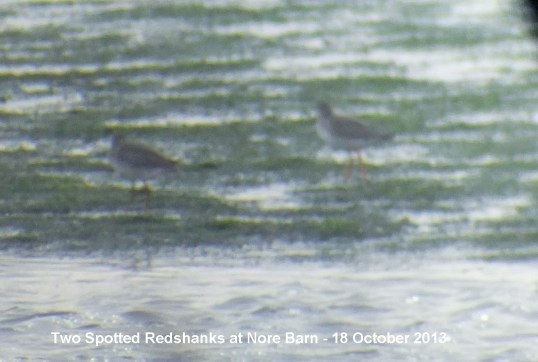
About 30
Black-tailed Godwits were feeding on the mudflats
at the end of Kings Road, but were too far away to
read any colour-rings. On the first visit I saw
three Pied Wagtails flitting around on the
edges of the stream.
I met Chris
Berners-Price who told me that the Spoonbill
was still at West Wittering yesterday. It would be
good to see it in Emsworth - the last Spoonbill we had
in the harbour was in December 2002 and I remember it
as if it was yesterday. Here is one of the many photos
I took of it at the time.
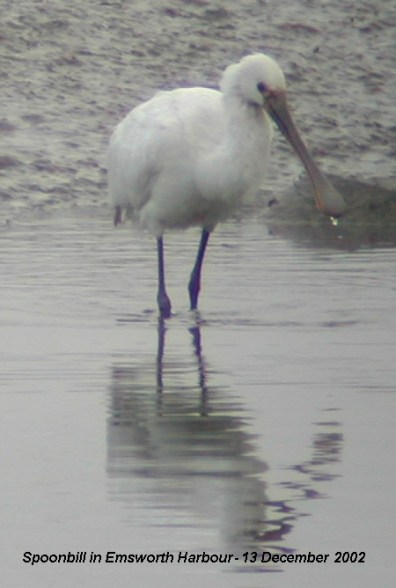
A visiting
photographer was at Nore Barn present in the
afternoon, squatting on the edge of the stream with a
huge lens camera. He got photos of the Greenshank and
the Godwit. But, do photographers with such big
cameras really need to get so close to the birds?
Fortunately, these birds are well used to people and
were not disturbed.

Several local
residents saw two dogs attacking swans in the harbour
again this morning. They obtained photos and have been
interviewed by the police. Let's hope they can put a
stop to this unpleasant behaviour. (see entry for Oct
14).
Brent
Geese
I found a total of 34
Brent Geese on the eastern and western mudflats
including 8 juveniles in broods of 4, 3, 1 and 1. This
brings my current percentage of juveniles to adults to
20% which looks like a good breeding season, though
the figures may be misleading as Brent families
usually assemble in the safety of the harbour away
from the large flocks. I suspect the final percentage
will be lower.
MILLPOND
NEWS
There were 10 Mute
Swans on the town millpond when I passed this
afternoon, including the nesting pair and their
cygnet. The cob of the nesting pair continues to strut
around the pond with wings raised, but with far less
effect on the other swans. It looks as if we may have
our swan flock back?
The usual autumn
influx of Coot onto Slipper Millpond has not
taken place so far this year. There's only the two
resident pairs on the pond along with 10 on Peter
Pond, including some of the juveniles from this year's
brood.
I have not seen the
Great Black-backed Gulls on Slipper Millpond
for a while. The Millpond Association AGM takes place
on Nov 1 at which the policy concerning future nesting
of the gulls on the centre raft will be discussed.
OTHER
NEWS
I found a
Helophilus pendulus hoverfly feeding on
Hogweed flowers on Brook Meadow.
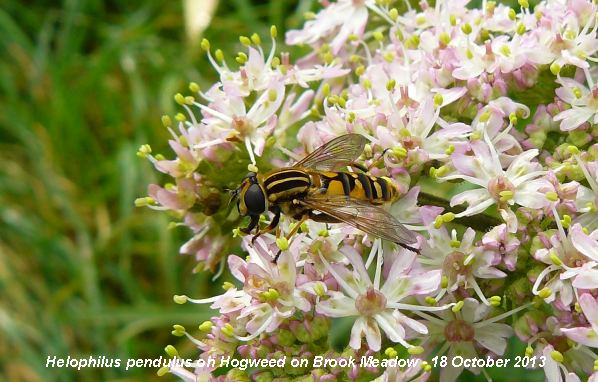
A few yellow petals of
Greater Celandine were just hanging on at the
end of the path from Seagull Lane to Lumley Mill.
There is a good crop of red Crab Apples on the
tree in the front garden of Boundary Cottage in Lumley
Road. Hopefully they will attract some wintering
thrushes. The tree had no fruit on it at all last
year.
SEMIPALMATED
PLOVER
Andy Johnson posted a
message on Hoslist this morning that he had discovered
a Semipalmated Plover on the wader roost at Black
Point Hayling Island. This is a North American bird
which is a rare vagrant to Europe and there have only
been two British records according to the Collins Bird
Guide, but is probably overlooked. Clearly, you need
to be an expert to identify the poor bird and Andy is
an expert! Naturally, Andy's news produced quite a
'twitch'.
Peter Milinets-Raby is
not one for twitching, but today he was very lucky to
have a driving instruction pupil that lived on Hayling
Island and finished the lesson at 11:30am which just
coincided with the Semipalmated Plover being
re-discovered on Black Point. In the hour gap before
his next pupil Peter managed to get this rather nice
photo of the first winter Semipalmated Plover on the
left along with what looks like a snoozing Dunlin on
the right.
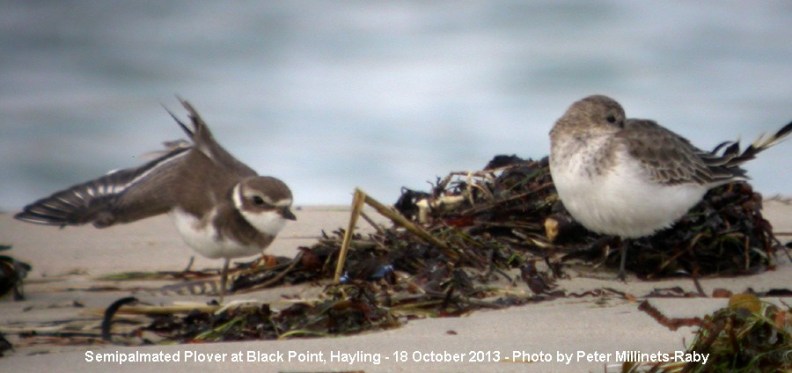
Latest news - Andy
Johnson reported that at 14:30 it flew off high NE
into Sussex. Goodbye?
THURSDAY
OCTOBER 17 - 2013
BROOK
MEADOW
I went over to the
meadow for the regular Thursday work session on a fine
warm morning after early rain. There was a good turn
out of 10 volunteers who were mainly concerned with
removing the recently lopped Crack Willow branches to
a safer location.
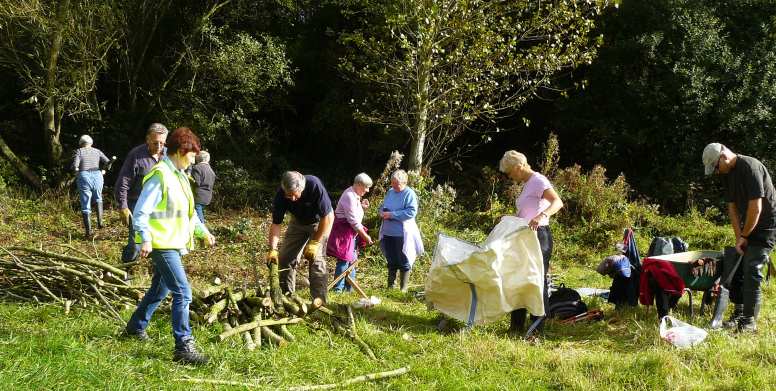
For the full report on
the work session and more photos go to . . .
http://www.brook-meadow.hampshire.org.uk/bm-diary-2013.html
Wildlife
observations
A Grey Wagtail
was flitting around the river just north of the
south bridge. Too quick for a photo. A very fresh
Red Admiral was seen close to where the
branches were being stacked. I saw another (presumably
different) one about an hour later on the Seagull Lane
patch.
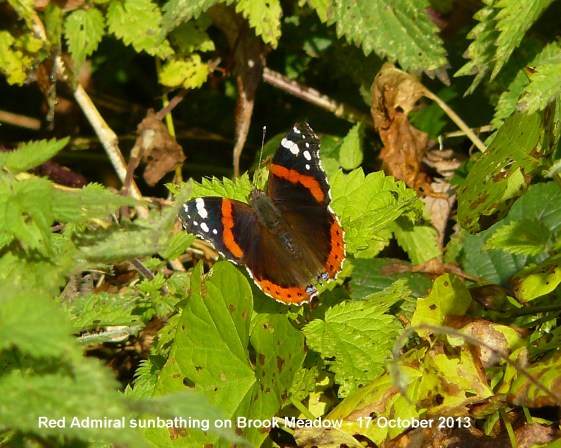
Lots of
'Nursery-web spiders' (Pisaura
mirabilis) were sunbathing on the nettle
leaves along the main river path. Some were in the
distinctive posture with their front two legs on
either side extending forward and very close together.
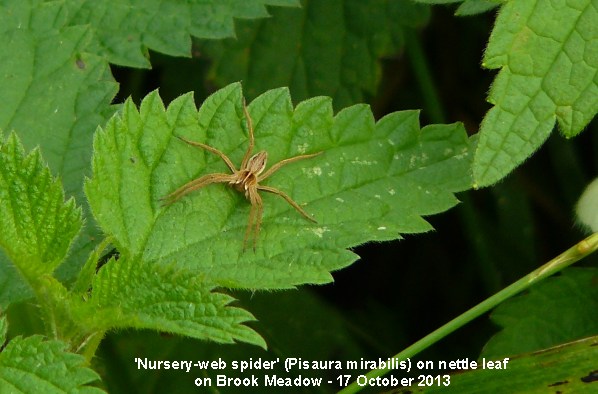
Plants in flower on
the meadow included Wood Avens, Yarrow, Herb-Robert,
Michaelmas Daisies, Hogweed (white and pink), Bramble,
Black Horehound, Hedge Woundwort, Red Dead-nettle,
Groundsel, Common Field Speedwell, Scentless Mayweed,
White Dead-nettle, Dandelion, Large Bindweed, Hedge
Bindweed, Hedge Mustard, Hoary Ragwort, Purple
Toadflax, Smooth Sow-thistle and False Oat-grass.
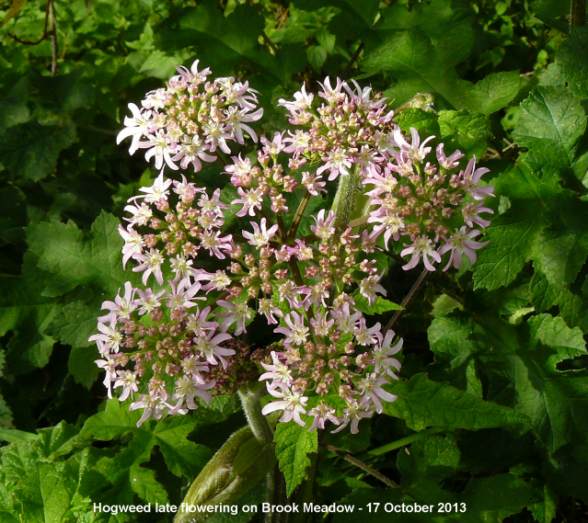
Plenty of bright red
berries adorn the Bittersweet plant on the river bank
in Palmer's Road Copse.
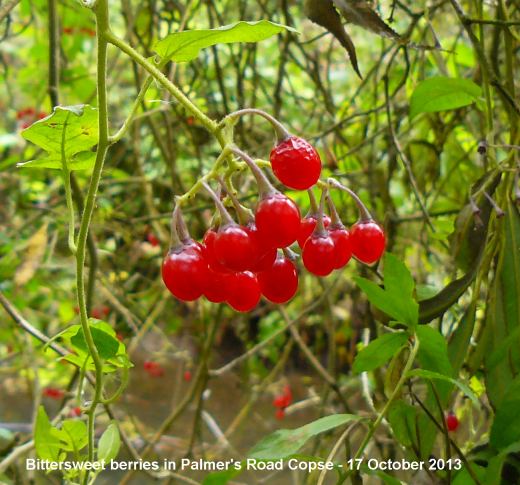
NORE
BARN
13:30 - 14:30 - 2-3
hours after high water. I watched the stream for about
an hour during which time four regular birds arrived
to feed, Little Egret, juvenile Black-tailed Godwit,
Greenshank and Black-headed Gull. There was no sign of
the Spotted Redshank while I was there.
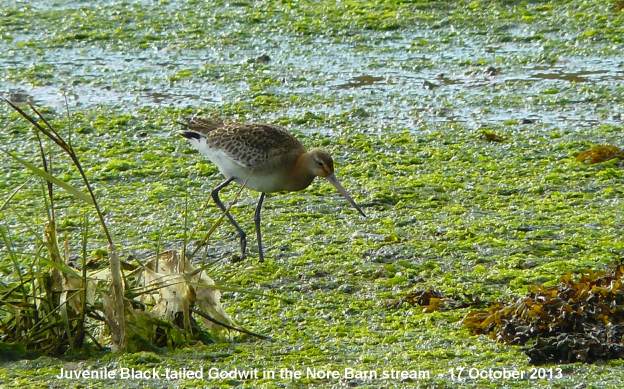
Honey
Fungus
On the way to Nore
Barn I came across a cluster of fungi growing at the
base of a Silver Birch tree on the roadside verge on
the south side of Warblington Road opposite house
Number 39. It looks like Honey Fungus to me which is
not good news for the Silver Birch tree. This is a
destructive species which kills a variety of trees and
shrubs and spreads to new hosts by sending what look
like 'black bootlaces' up the trunk just below the
bark, choking the vessels which carry the tree's
nutrients.

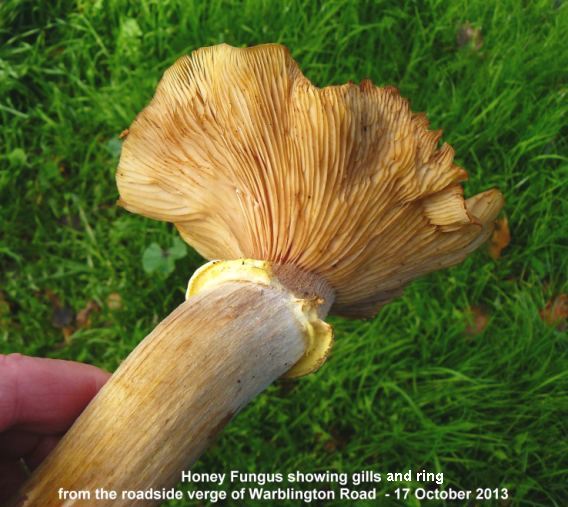
WARBLINGTON
SHORE
Peter Milinets-Raby
was on the Warblington shore from 7:35am until 9:25am.
The birds of note were as follows:
Ibis Field (east of
the cemetery extension): male and 3 female Pheasants,
Chiffchaff Green Woodpecker.
Off Pook Lane: 9
Wigeon, 67 Brent Geese, 7 Grey Plover, 32 Dunlin, 30+
Teal, 2 Black-tailed Godwits (one with coloured rings
R-R/OG - where Red is above and below the knee. The
first I have recorded - probably one of the new batch!
60+ Bar-tailed Godwits (Flew off just as I was
counting them!)
Off Conigar Point:
Migrant movement noted by 12 Skylarks (mostly singles,
one group of 4), 22 Meadow Pipits and 2 Siskin. 3
Pintail (male, female and eclipse male), 48
Wigeon
133 Teal, 12 Brent
Geese, 11 Grey Plover, 3 Black-tailed Godwits,
Greenshank (coloured ringed RW/BtagY. Cetti's Warbler
heard singing just the once from reedbed. Chiffchaff
in Tamarisk Trees. 35+ Linnet flock in big field next
to point. Rock Pipit.
FARMLAND
BIRDS DECLINE
Keith Betton reports
on the latest official figures on farmland birds
released today by the RSPB which show they are
continuing to decline. The Farmland Bird Index - which
covers 19 species reliant on the farmed countryside -
has seen a five year decline of eight per cent.
Looking back over 40 years the long term decline in
farmland birds is 50 per cent, however the decline has
slowed in recent years.
Turtle Doves are the
fastest declining species - down 95 per cent since
1970 - and reports from earlier this year suggest it
is the worst year ever for sightings. Other species
hit hard include Lapwings, which are down 63 per cent
since 1970; Corn Buntings, down 90 per cent; and
Skylarks, down 59 per cent. Species that are doing
well include Jackdaws, whose numbers have increased by
140 per cent since 1970, and Woodpigeons, which are up
134 per cent.
WEDNESDAY
OCTOBER 16 - 2013
EMSWORTH
HARBOUR (east)
14:30 - 15:30 -
Viewing from the millpond seawall. About 4 hours after
high water. Conditions were good with a bright sun
from behind, but a strong wind.
A good flock of 78
Black-tailed Godwits was close in on the near side
of the channel, a few were feeding, but most were
snoozing while standing on one leg. They only moved
once in the hour I was there, but as that was to
change legs, it gave me the chance to check for
colour-rings. I managed to read four combinations, all
are Emsworth regulars and have been previously seen
this season. L+LL - G+BG - R+YN - RLR+ROL (Kent
ringed).
Four Greenshank
were feeding on the edge of the main channel including
two colour-ringed birds:
RG+BY (geo) - caught
at Thorney and fitted geolocators to the blue rings.
The blue ring is looking black. Last seen in Emsworth
Harbour on 26-Sep-13.

YN+LG ? - Not 100%
sure about this one. Not seen it before in Emsworth.
Here is my poor digiscoped photo.
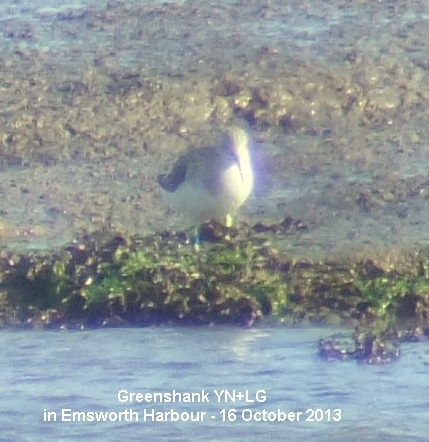
Two Little Egrets. No
sign of the Spoonbill that was at West Wittering
yesterday. Three Brent Geese swimming up the main
channel. A Curlew was settled on the edge of the town
channel - quite an unusual sight.
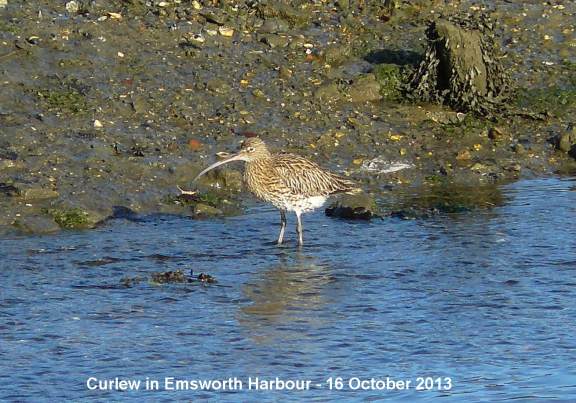
GODWIT NEWS
Kent
sightings
Dudley Hird reports
there are over 3,000 Black-tailed Godwits on the three
main sites around the Kent estuaries at present. Some
of the colour-ringed Godwits that have been recorded
this autumn in Emsworth Harbour have also been seen in
Kent. The first two clearly dropped into Kent on the
way here. The third one was a maverick and went the
other way!
ROL-RLR was in Kent on
6-Oct-2013 and in Emsworth 8 days later on
14-Oct-13
W+WN was in Kent on
5-Aug-2013 and in Emsworth on 26-Sep-13.
L+LN went the other
way as it was in Emsworth on 27-Aug-13 and was seen a
month later in Kent on 25-Sep-2013. I recall Godwits
in the past flying to and from Kent on occasions.
Farlington
ringing
There was a successful
colour-ringing session at Farlington Marshes yesterday
(October 15). In total, Pete Potts and his team caught
and ringed around 90 Black-tailed Godwits, 3 Shoveler,
3 Knot, 12 Redshank, 2 Dunlin, 14 Teal and a
Bar-tailed Godwit. So, there will be a few more
colour-ringed Godwits to look out for locally. For the
full report along with some photos go to . . .
http://solentreserves.wordpress.com/
TUESDAY
OCTOBER 15 - 2013
EMSWORTH
HARBOUR
Tide falling from high
water at 09:23. Weather, calm, bright sun.
Birds
in the Nore Barn stream
- 11:30-12:00
- Two hours after high water. Little Egret and
Greenshank were present when I arrived later joined by
the juvenile Black-tailed Godwit. But there was no
sign of Spotted Redshank, though it came in quite late
yesterday. I do recall last year that the bird took
some while to settle down into a routine of visiting
the stream.
Insects
- I saw two Red Admirals along the shore by the woods,
one of which settled for a photo.

Lots of insects were
feeding on the Ivy flowers on the large hedge at the
end of Warblington Road.
Swans
on the Millpond
- 10 Mute Swans were on the town millpond when I
passed by, plus another two in the harbour near the
quay. The nesting pair were also present and made
half-hearted attempts to chase off the other birds,
but with no effect. I think they have now come to
tolerate the presence of these companions.

No
Godwits
Unlike yesterday,
there were no Black-tailed Godwits on the town shore,
but I did not wait for them to arrive.
NUTBOURNE
14:30 - 15:30 - I had
a walk along the coastal path from Nutbourne Bay
towards Prinsted this afternoon. The tide was way out
and the sun was too strong for easy birdwatching.
There were masses of Wigeon in the bay along with a
few Black-tailed Godwits. I managed to age a flock of
103 Brent Geese which included 15
juveniles in broods of 5, 4, 2, 3 and 1.
Meadow Pipits were
active in the bushes, along with the occasional
Stonechat. This female Stonechat perched for a
photo surrounded by autumn fruits.

I got a good view of a
pair of Kestrels hunting on the old Conservancy meadow
at the end of Farm Lane. I used to found Snipe in this
meadow, but sadly no longer as it is seriously
overgrown with scrub.
MONDAY
OCTOBER 14 - 2013
EMSWORTH
HARBOUR
Tide falling from high
water at 08:14. Weather, light wind and occasional
sun.
Birds
in the Nore Barn stream - 10:00 - 11:30
10:00 - The
Greenshank was already present in the stream
when I arrived shortly to be joined by the Little
Egret. A little later a second Little Egret
arrived, but was not tolerated by the resident Egret
and was chased off. The same happened to a second
Greenshank which landed very briefly in the stream
only to be promptly seen off by the resident
Greenshank. I have noticed this behaviour on other
occasions before - defending a good feeding site? The
Greenshank and Egret fed together quite happily for
the next hour or so as the stream gradually emptied of
water. They were joined on occasions by a Black-headed
Gull and a Woodpigeon, but they did not stay for long.
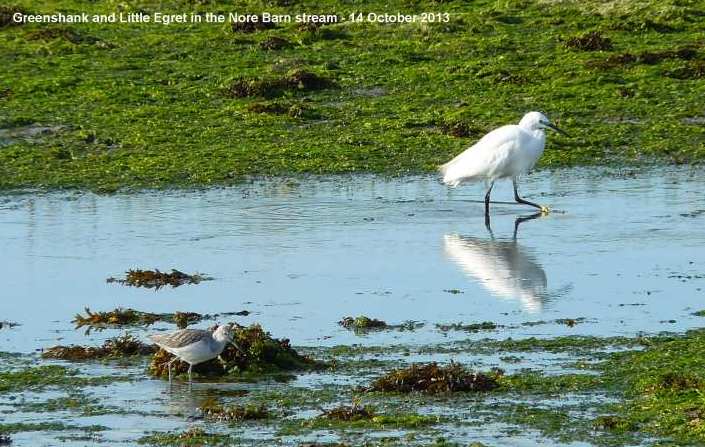
10:45 - a Grey
Plover arrived in the stream, feeding on the far
bank.
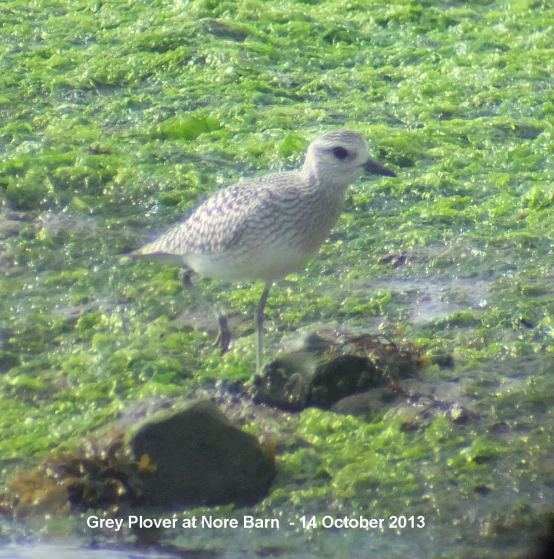
11:30 - the Spotted
Redshank finally turned as I was about to leave.
It immediately attracted the attention of its 'friend'
the Greenshank and both birds began feeding together
in the lower part of the stream.
I counted a total of
40 dog walkers passing the Nore Barn stream in
the hour and a half I was present, but fortunately
there was no disturbance of the birds feeding in the
stream at all. However, I met a lady, whose house
overlooks the stream, who was very concerned about the
lack of control displayed by one owner in particular
whose two dogs daily are allowed to run loose into the
stream and over the mudflats, disturbing the birds.
These were the dogs responsible for savaging the Mute
Swan a few weeks ago, when the owner was spoken to by
the police and the local dog warden, but seemingly
with little effect.
Black-tailed
Godwits
Nore Barn -
about 10 Black-tailed Godwits settled on the
saltmarshes on the far side of the channel. and some
came onto the mudflats to feed of which one was
colour-ringed:
OY+LR - Ringed
as a chick in Iceland in July 1999 which makes it 14
years old! It has been seen fairly regularly in
Emsworth Harbour since 2004, usually early in the
winter season (Aug-Dec) with a total of 33 sightings.
First sighting this season.
Eastern harbour -
11:45 - 12:30 - From The Fishermans outlook I got
a very good view of a flock of 132 Black-tailed
Godwits on the town shore. Most were snoozing on one
leg, but some were feeding on the edge of the channel.
I went through most of them for colour-rings and found
the following two combinations - first sighting this
season, but fairly regular visitors in previous
winters.
LY+RO - Ringed
in Iceland as a breeding male in June 2003 which makes
it at least 11 years old. It has been seen in Emsworth
Harbour occasionally since 2003, usually in autumn
(Oct-Nov) with a total of 13 sightings.
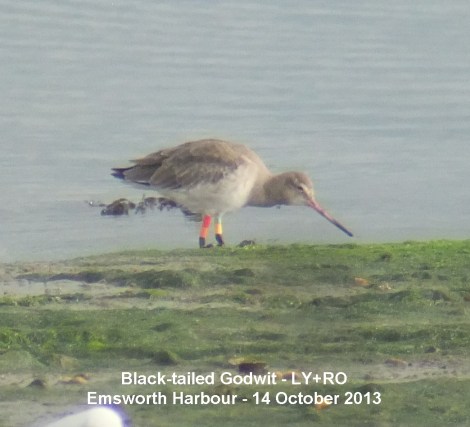
ROL+RLR -
Ringed on 27-Oct-08 at Kingsnorth Power Station,
Medway Est. Kent as an adult male. This bird has been
seen very regularly in Emsworth Harbour each winter
since 2009 with a total of 65 sightings. It is also
seen early in the season by Dudley Hird in Kent.
I found a small group
of 5 Brent Geese on the mudflats east of the
Emsworth Sailing Club building. They were the only
Brents I saw all morning.
EMSWORTH
MILLPOND - Mute Swans return
I was surprised to
find 12 Mute Swans on the southern part of the
millpond. These are probably the ones that have been
regularly gathering in the harbour beneath the
millpond seawall and have finally ventured onto the
pond without being driven off by the resident nesting
pair.
LANGSTONE
HARBOUR
Peter Milinets-Raby
was out this morning for a walk along to Langstone
Mill Pond via Wade Court Lane (9am to 11am) then
across the main road via the Billy Trail to overlook
Langstone Harbour from the bridge.
Migration was still in
evidence with three flocks of Meadow Pipits flying
over (totalling 32 birds), 2 Skylark 4 Pied Wagtails,
2 Swallows and 2 Siskin flying over. 1+ Chiffchaff
calling from trees along Wade Court Lane.
On the pond: 2
Shoveler (still in eclipse), 27 Teal (half in eclipse,
some nice males), 6 roosting Little Egrets and 8 Grey
Herons siting out high tide (the most I have seen).
Grey Wagtail fly over. Kingfisher heard twice, but not
seen. Only 2 juvenile Mute Swans with their parents.
Other cygnet probably flown? In the air at once over
the pond Peter had Buzzard, male Sparrowhawk and a
female Kestrel.
Off Langstone Bridge:
97 Brent Geese, 48 Wigeon, 6 Great Crested Grebes, 3
Common Scoter, male Goldeneye, 2 Rock Pipits and 3
Grey Plover on the shore.
FRIDAY
OCTOBER 11 - 2013
NORE
BARN
Spotted
Redshank returns for 10th winter
14:30 - 15:00 - about
two hours to high water. It was pouring with rain when
I arrived at Nore Barn which continued during the
whole of my stay. But that did not dampen my spirits
at all, as the first bird I saw in the stream was a
Spotted Redshank.
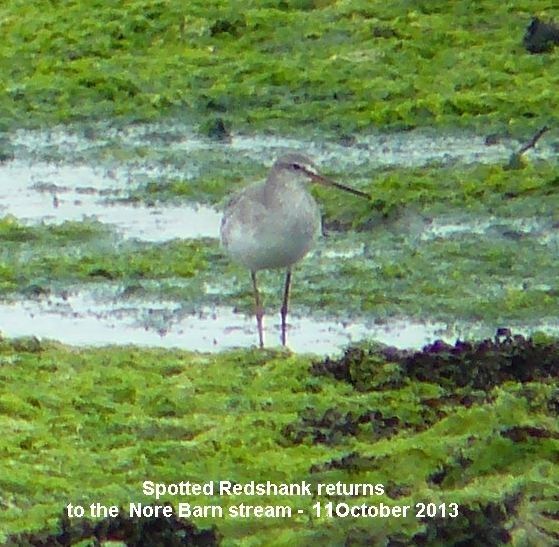
But was it THE Spotted
Redshank? I watched it feeding and it began to look
more and more like the 'tame' bird that had been
coming here to feed for the past 9 winters. I became
more certain when the Greenshank arrived to feed in
very close company with its 'friend'.

Other birds arrived to
feed in the stream as I was watching, including the
now regular juvenile Black-tailed Godwit, the Little
Egret and a Common Redshank, plus a group of Mute
Swans.

Dog
disturbance
I managed to take a
few photos from under my umbrella before a boisterous
dog chased all the birds from the stream. I had a word
with the owners asking them politely if they would
consider putting their dog on a lead when passing by
the stream in future, as the dog had just disturbed
several migrant birds which had just arrived after a
long journey from Northern Scandinavia. They replied
that they were not aware of the presence of the birds
and would do so in future. Whatever happens they are
now aware of the birds and let's hope come to
appreciate the need to allow them to feed undisturbed.
Conclusion
I was finally
convinced that the Spotted Redshank was the regular
wintering bird when it returned about 5 minutes after
being chased off along with the Greenshank, Little
Egret and the juvenile Black-tailed Godwit. This
Spotted Redshank has now returned to feed in the Nore
Barn stream for the 10th winter running.
There is no doubt in
my mind that it is the same bird that has come back
each year; it arrives and leaves on schedule and
behaves in exactly the same manner and is 'tame'. This
year it was two days later than last year, but is the
second earliest on record. See all the arrival and
departure dates at . . . Spotted
Redshank at Nore Barn
OTHER
NEWS
While looking around
the Bridge Road Wayside I came across a badly decayed
and eaten corpse of a large dog-like animal, probably
a Fox.
THURSDAY
OCTOBER 10 - 2013
EMSWORTH
HARBOUR
Tide rising to high
water at 15:42
Eastern
harbour -
12:00 -13:00 - From the Fishermans lookout I got a
good view of the Black-tailed Godwit roost that
was progressively developing as the tide pushed in. My
final count was 134 all clustered together on a small
mud island near the south shore. They included two
colour-ringed birds: O+WL - 2nd sighting this autumn.
G+WR - 5th sighting this autumn.
16 Mute Swans
had gathered in the harbour beneath the quay, no
doubt awaiting their chance to get back onto the
millpond, though this is still dominated by the
resident nesting pair.
Western
harbour -
13:00 - 14:00
As I made my way along
Western Parade towards Nore Barn I spotted a bright
yellow Clouded Yellow. It came to rest on the
back lawn of one of the houses overlooking the
harbour.

I got to Nore Barn at
13:30 by which time the tide was well advanced. I
found 56 Black-tailed Godwits feeding on one of
the remaining mud islands in the harbour. I have no
idea if they were some of the birds I saw in the
eastern harbour, though I did not see any flocks in
flight.
By the time I left
Nore Barn at about 14:00 birds in the stream included
3 Mute Swans, the juvenile Black-tailed Godwit, an
unringed Greenshank and two Little Egrets. There was
no sign of Spotted Redshank, which last year had
arrived by now, though that was specially early.
Here
is the Greenshank standing on a rock as the water
rises around

THORNEY
NEWS
Ros Norton walked down
the west side of Thorney this morning as far as the
deeps and saw 2 Stonechats, 1 Wheatear, 1 Clouded
Yellow and a Small Copper.
COLLARED
DOVE GARDEN DECLINE
Keith Betton reported
on Hoslist a decline in Collared Doves in his garden
(from up to 10, down to maybe just 2), and noted a
couple of similar comments in the Hampshire Bird
Report. Keith noted also that results just in from the
BTO's Garden BirdWatch show that the Collared Dove has
declined by a quarter in gardens in the last decade.
One reason for this could be the increasing Woodpigeon
numbers - the two birds perhaps competing for similar
food and habitat. However it is thought that Collared
Doves could be more susceptible to the illness
trichomonosis than Woodpigeons and that the rise in
disease incidents might be having an effect on the
Collared Dove population. Keith also noted that
Sparrowhawks killed at least four Collared Doves in
his garden in the last three years. He asked what
others have experienced.
My own experience
since I started the GardenBirdwatch recording in my
present urban garden in the village of Emsworth in
1997 mirrors that reported by Keith and the BTO. After
a steady increase from a weekly mean of 1.9 in 1997 to
a peak of 8.2 in 2008 with a constant 100% presence,
the weekly mean plummeted to 3.4 in 2009 and was only
2.2 in 2012, with only around 80-90% presence.
However, there does appear to be signs of a recovery
this year with a weekly mean of 3.9 and a 100%
appearance.

Keith mentions
Woodpigeons as a possible reason for the
decline. In my garden (as in the Garden BirdWatch
generally) Woodpigeons have increased over the past 15
years with the weekly mean steadily rising from 0.3 in
1998 to 2.1 in 2008 after which it stabilized. But I
have not seen any obvious signs of the two species
competing for food that I put out for the birds.

I did not realise that
Collared Doves were subject to the illness
trichomonosis which has so devastated the Greenfinch
population since 2006. But that could be a factor
certainly as the decline in Collared Doves began two
years later in 2008. Interestingly,
Chaffinches. which also suffered from
trichomonosis, declined in my garden at the same time
as the Collared Doves, down from a weekly mean of 5.5
in 2008 to 2.5 the following year. And, like Collared
Doves, Chaffinches are showing signs of recovery this
year - up to weekly mean of 4.5 so far.

As for Sparrowhawk
attacks, I only recall seeing one pile of feathers,
probably from Collared Dove in the garden over the
past year. I do not see this as a likely cause.
WEDNESDAY
OCTOBER 9 - 2013
EMSWORTH
HARBOUR
Eastern
harbour -
11:00 11:30. Tide rising to high water at 14:50. I
counted 58 Brent Geese off the Thorney seawall
- my biggest count so far this autumn. They were too
far away for aging.
A flock of 120
Black-tailed Godwits assembled at their regular
roost on the western edge of the main channel as the
tide rose - best seen from the outlook at the end of
Fisherman's Walk.
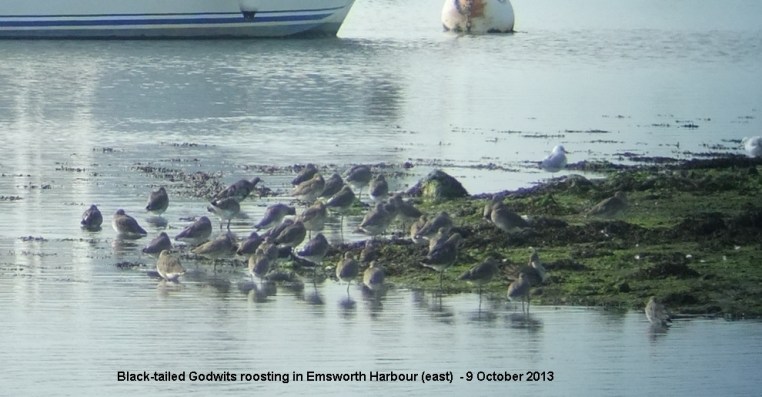
I found two
colour-ringed birds: L+LL - Third sighting this
autumn. R+YN - Only one other Emsworth sighting on
20-Nov-10. Other birds in the harbour included 80+
Redshank, 10 Turnstone (with the Godwits).
Western
harbour 11:30
- 12:45. There was a good collection of ducks in the
main channels, roughly 150 Teal and 60 Wigeon. There
was no juvenile Black-tailed Godwit in the Nore Barn
stream today, nor any sign of Spotted Redshank.
However, the regular Little Egret and Greenshank did
turn up just before I left at 12.45.
Interestingly, one of
my photos showed the Greenshank 'spurting'. I
have just one other photo showing a Greenshank
spurting taken on 08-Feb-12 at Nore Barn. This is the
first example I have of this behaviour (which so
puzzles the experts) in any wader this season. For
more information go to the special 'spurting' page at
. . . Spurting
behaviour
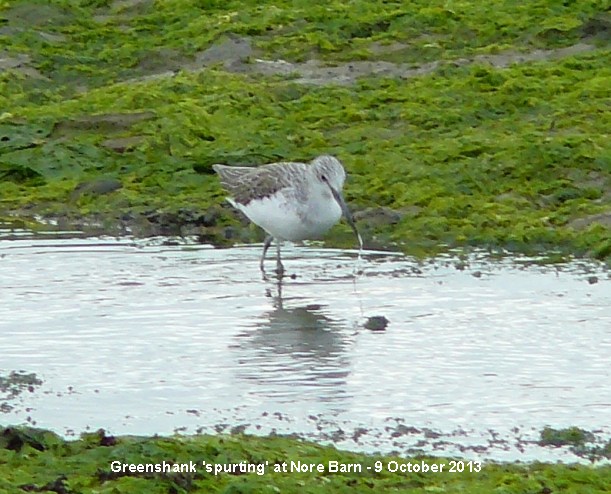
RAILWAY
WAYSIDES NEWS
I had a quick look at
the wayside to the north of Emsworth Railway Station
this afternoon. I was surprised to find a new
trench had been dug along the whole length of the
land to the north of the wayside from New Brighton
Road. The trench went beneath the path leading from
Washington Road to the Recreation Ground and into the
field where the new service station on the south side
of the A27 trunk road is being constructed. This
trench clearly accounts for the recent clearance of
vegetation along this stretch.
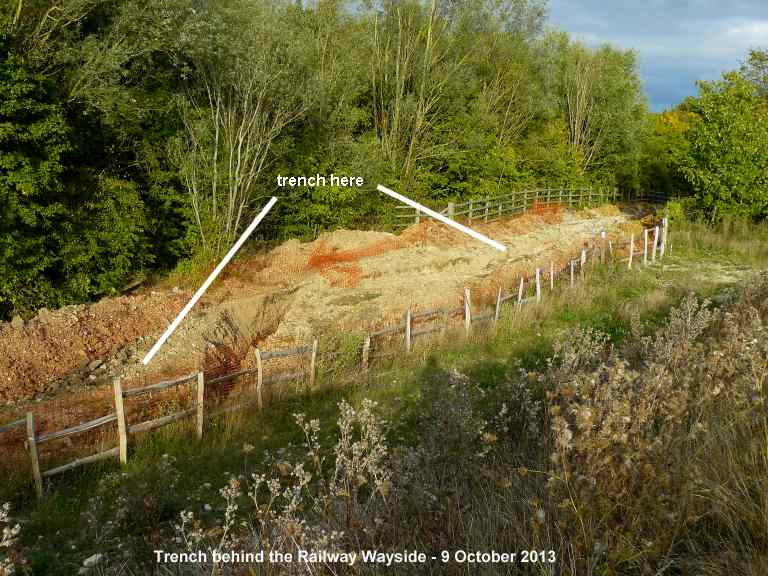
I noticed a late
flowering of Marsh Woundwort on the Railway
Wayside close to the new ramp.
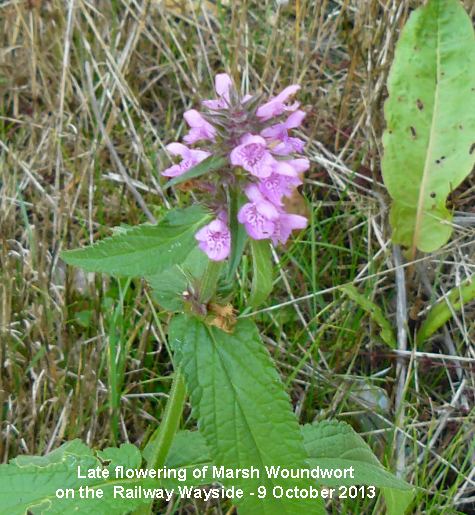
TUESDAY
OCTOBER 8 - 2013
EMSWORTH
HARBOUR
Tide rising to high
water at 14:00. Beautiful morning, but the sun was a
bit bright.
Eastern harbour -
10:30 About 50 Black-tailed Godwits were assembled
in the usual spot on the edge of the main channel.
Western harbour -
11:00 - 12:00. Good numbers of Teal and Wigeon
were in the channels, but no Brent Geese. No sign of
the Spotted Redshanks that I saw yesterday. The
juvenile Black-tailed Godwit was feeding in the Nore
Barn stream for the second day running; it has clearly
discovered a good source of nourishment.
I walked along the
shore to the south of the woods where a group of
Starlings were whistling and chattering away in a
big Bramble bush just before the interpretation board.
I have seen and heard them in this bush several times
in the past. One of the Starlings perched conveniently
on a small twig for me to take a photo.
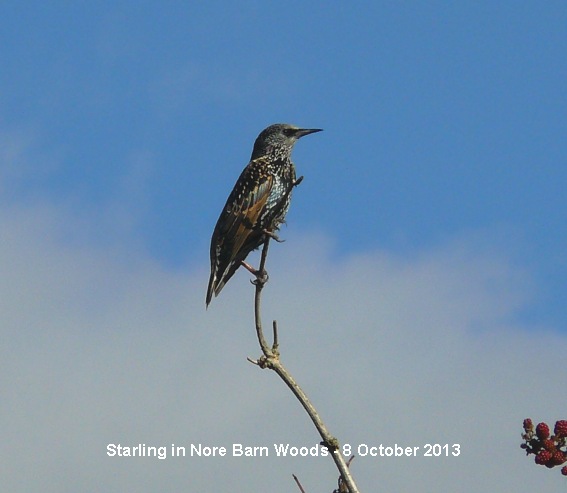
A little further along
the shore where the seawall reconstruction is taking
place, I found the Chicory plant in full flower
(previously seen on Sep 18), with a A Drone Fly
(probably Eristalis tenax) feeding.
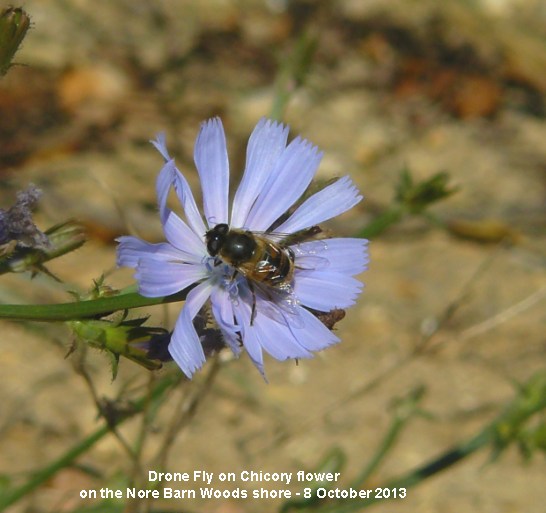
12:00 - Back to the
Nore Barn stream I was pleased to meet Peter
Milinets-Raby and his young son Aleksandr who were
also looking at the birds. We waited watching the tide
come in, but there was no sign of the Spotted
Redshank. A Little Egret flew into the stream and
immediately shooed off another Egret that had been
feeding there.
I cycled along the
coastal path towards the Emsworth Sailing Club
building where I counted a flock of 136
Black-tailed Godwits feeding on the shore. Most of
the birds were in water, so I was only able to check
about 40 of them for colour-rings, but found none.
This is clearly the regular Emsworth Godwit flock
though they have not got around to feeding on the Nore
Barn mudflats, which they usually prefer later in the
winter.
BROOK
MEADOW
Peter had just come
from Brook Meadow where he saw 4 individual
Chiffchaffs from various parts of the meadow, though
he though some of the sightings might be duplicates.
He bumped into a very
vocal Tit flock near the railway tunnel consisting of
7 Long-tailed Tits, 4+ Great Tits, 6+ Blue Tits and 1
Chiffchaff. Birds seen flying overhead included Grey
Heron, Meadow Pipits, Chaffinches and 3 Swallows. He
saw good numbers of butterflies: Red Admiral (2+),
Whites (4+), Comma (1) and Small Copper (1+) and other
'Little Ones' up high in the trees near the car park
(3+), possibly Speckled Woods?
MONDAY
OCTOBER 7 - 2013
EMSWORTH
HARBOUR
Tide rising to high
water at 13:30. 09:30 - Looking across the western
mudflats I counted 164 Teal - by far the
largest count so far this season. Apart from gulls,
the only other birds on the mudflats were a few
Black-tailed Godwits (10+), Redshank, Dunlin and
Curlew. What I assume was the regular Greenshank was
in one of the small channels at Nore Barn.
10:30 - A juvenile Black-tailed Godwit was
feeding alone in the stream at Nore Barn. It was still
there an hour later when I left.
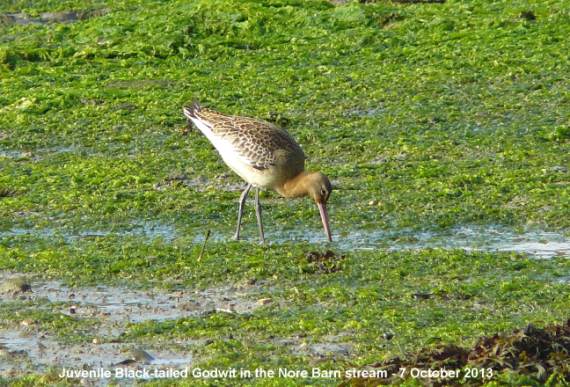
Two Spotted
Redshanks were on the far side of the Nore Barn
creek. I watched them for about 30 minutes as they fed
together before they both flew off east, coming to
rest on the edge of the main saltmarshes. Neither of
them was colour-ringed. They did not come into the
Nore Barn stream so I assume neither was the regular
'tame' Spotted Redshank that has wintered here for the
past 9 years.
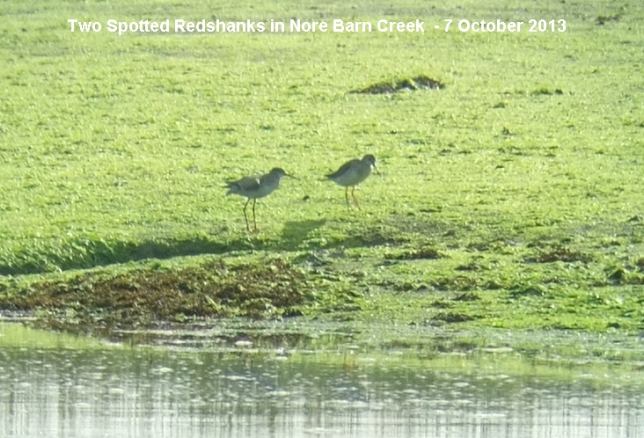
11:30 - I could see a
line of about 140 Black-tailed Godwits on one
of the fast disappearing mud islands far out on the
western mudflats.
WATER
VOLES IN HAVANT
I have received three
extra contributions about the recent sightings of
Water Voles in Havant, in the small pond north of the
Bosmere School grounds and south of the newish Mencap
centre called Dolphin Court, where the Dolphin pub
used to be.
Martin Hampton says
"in the last year or two I have, on five or six
occasions, seen Water Voles feeding in the stream
alongside Tesco, just north of the A27. I guess the
channel here is part of the old water mill. It would
only be a short-ish trip from there following the
stream, albeit under the road, to the pond".
I passed Martin's
comments to Nik Knight who provided more details about
the complex watercourses in that area. Nik says, "the
the water from the Dolphin spring is joined by the
water from the Homewell spring and then flows under
Park Road South to the old millpond site (Langstone
Gate, the ex De La Rue offices). That is later joined
by the flow down the 'River Lavant' which has come
from Rowlands Castle, under Havant town centre and
then past the pet shop and Tesco. So all these
watercourses link up, becoming what locals refer to as
the 'Langbrook Stream' which leads under the A27 and
past Bosmere field to reach the sea at the end of Mill
Lane, Langstone."
Another significant
contribution to this discussion comes from Tim Abel
who indicates the voles have been there for longer
than we have previously acknowledged. He says, "There
have been Water Voles on that stream to my knowledge
since the early 1970's. I used to travel along the
river in front of what used to be IBM Havant (now
Langstone Technology Park) every day and there was
often a Water Vole to be seen munching the watercress
just north of the road bridge into the site (off the
Hayling road, I don't mean the A27 bridges). I saw
them there as recently as last year so it has been a
continuous habitation for over 40 years."
COLIN'S
IMAGES
Colin Vanner sent some
excellent images from his walks yesterday. First a
Hornet in Southwick Woods. Colin said the insects were
everywhere, not swarming just flying around separately
and sitting in the sun.
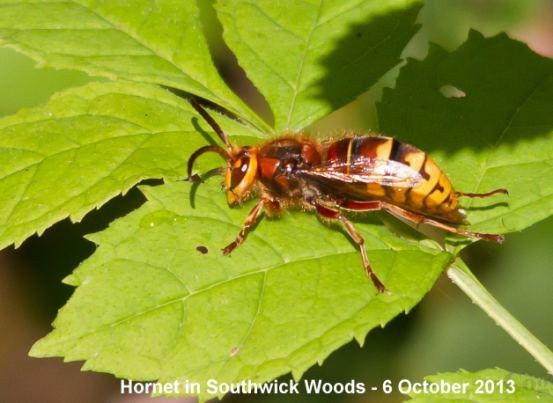
and
this female Kestrel with a kill at Farlington
Marshes
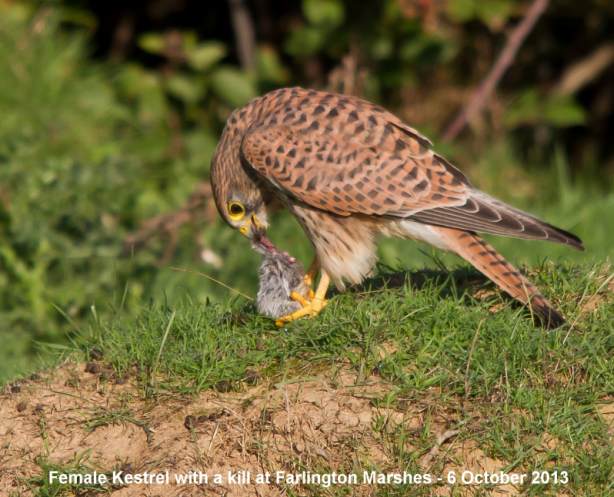
SATURDAY
OCTOBER 5 - 2013
Nore
Barn
15:30 - About 3 hours
after high water. No sign of the Spotted Redshank in
the stream as yet, just one Greenshank and a Little
Egret. However, there was a flock of 34 Shelduck
far out in the channel - the best number so far.
While I was watching them a group of 6 Brent Geese
flew in, a family of 2 adults and 4 juveniles.
This augurs well for the breeding success of the
Brents. Perhaps this family will spend the winter here
in Emsworth. There were no Black-tailed Godwits at all
on the western mudflats and I only found 5 of them
feeding on the mudflats east of the Emsworth Sailing
Club building. Maybe, the flocks I saw earlier have
moved on?
Ivy flowers are
starting to open on the large hedge on the coastal
path at the end of Warblington Road.
Emsworth
Millpond
I was surprised to
find two Mute Swan families on the millpond when I
passed this afternoon. The regular family with their
one cygnet was at the northern end of the pond near
the bridge. A second family, also with one cygnet, was
in the southern section of the pond. I suspect this
was the family from the Peter Pond nest. The presence
of 4 other swans on the millpond caused me to wonder
if the 'resident' nesting pair was becoming more
tolerant of the presence of other swans on the pond.
Brook
Meadow
Malcolm Phillips was
on the meadow yesterday when he saw Small
Copper, Comma and a large Dark Bush-cricket and
found two dead shrews and a dead frog where the grass
had just been cut, presumably victims of the cutting
that has taken place in the past week.
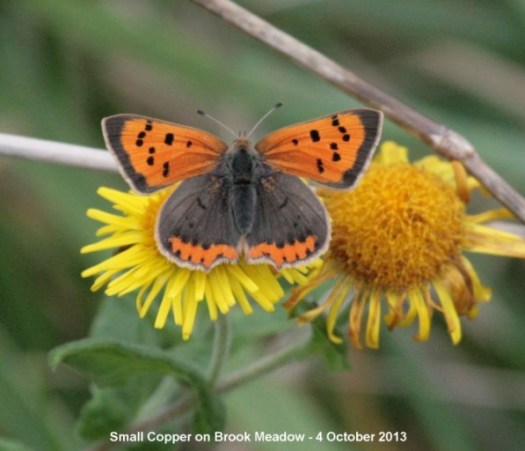
Patrick Murphy was
walking back from the village through Brook Meadow
when he found a Red Admiral sunning itself on a
tree trunk in today's morning sun. Patrick says the
butterfly's colouring looked fresh and vibrant -
suggesting a recent hatching? He said the photo was
the correct way up - the butterfly was face downwards
situated on a tree trunk on east side of causeway path
between sluice gate and S-bend.
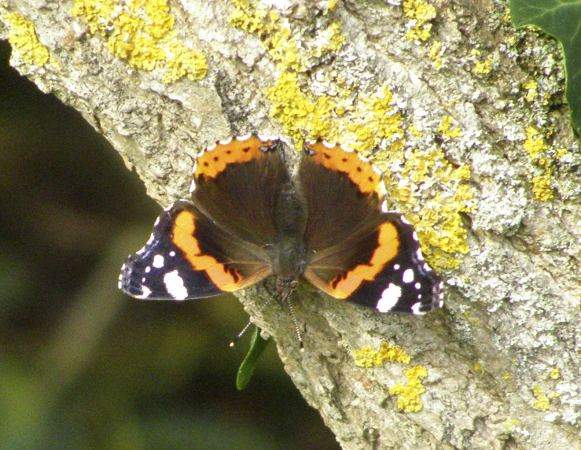
Bridge
Road Wayside
The Environment Agency
have strimmed the edges of the Westbrook Stream in the
Bridge Road Wayside for their annual autumn cut.
Thoughtfully, they avoided cutting down the Bulrushes
flowers in the southern part of the stream. They
chopped branches from the Goat Willow and left them on
the grass verge.
Rare
birds on the Somerset Levels
BTO News reported
"Conservationists in Somerset are celebrating this
week with the news that the Avalon Marshes has had its
best year ever for breeding birds. The Avalon Marshes
is a huge wetland recreation site to the west of
Glastonbury managed by Natural England (NE), Somerset
Wildlife Trust (SWT), Hawk and Owl Trust and RSPB.
Following the first UK
nesting Great White Egrets last year in the
marshes, this summer has seen two pairs nest; one
again at Natural England's Shapwick National Nature
Reserve (producing two youngsters) and a new pair
within the boundary of the RSPB's Ham Wall nature
reserve (producing three young).
The RSPB reserve at
Ham Wall has also been host to a nesting pair of
Little Bitterns. This is the only known UK
breeding location for these remarkably shy and
diminutive members of the heron family and this year
two young birds successfully fledged.
And, to add to the
totals, Great Bitterns have had yet another
amazing year across the Avalon Marshes. On RSPB, NE
and SWT land, as many as 33 "booming" males have been
heard across the wetlands. This makes the area now one
of the UK's hotspots for this rare and remarkable
bird.
Alongside the nesting
bitterns and egrets, the wetlands have also provided a
home for Marsh Harriers, with four nests
producing thirteen young."
I was pleased to make
my first ever visit to the levels this summer and I
can highly recommend them.
WEDNESDAY
OCTOBER 2 - 2013
BROOK
MEADOW
I visited the meadow
this morning mainly to collect a few plants for
display at the AGM this evening. There is a good late
flowering of False Oat-grass on the edge of the cut
area on the north meadow. There is a splendid crop of
flowering Michaelmas Daisies on the Lillywhite's patch
close the garden of Gooseberry Cottage. I collected
some of these for the display.
Malcolm Phillips sent
me this fine image of a late flying Comma that he took
on the meadow which I used in my wildlife review of
2013 for the AGM.
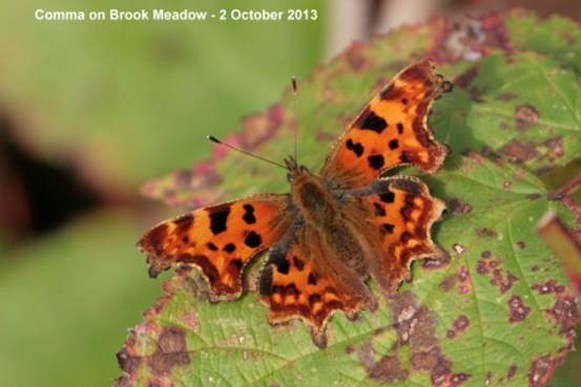
EMSWORTH
HARBOUR
I checked the western
harbour from 1-2pm with the tide falling. The only
birds in the Nore Barn stream were one Little Egret
and 7 Mute Swans. A single colour-ringed Greenshank
RY+YY arrived which I have not previously seen.
Possibly a newly ringed bird? Surprisingly, the
Black-tailed Godwits did not show up in the time I was
there. I had two firsts for the winter season. A
single Brent Goose was far out on the western
mudflats and a Great Crested Grebe was swimming
in the main channel.
Lesser
Sea-spurrey was flowering on the edge of the
tarmac path leading to the stream. Sepals longer than
petals.

WARBLINGTON
BIRDS
Peter Milinets-Raby
had a good morning down Warblington shore (7:07am to
9:38am) on an incoming tide.
Off Pook Lane: 72
Dunlin, 3 Black-tailed Godwits, 2 Greenshank, 6 Grey
Plover, 68 Bar-tailed Godwit, 7 Lapwing, 3 winter
plumaged Knot, Snipe flew over heading south. Yellow
Wagtail 3 over south east and 2 in with cattle. In the
hedges were 3+ Chiffchaff and a male Blackcap. Here is
one of the wagtails.
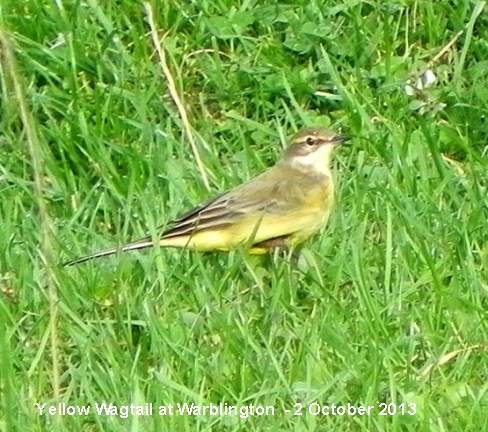
Off Conigar Point: 3+
Chiffchaff in Tamarisk trees (one singing),
Whitethroat, Cetti's Warbler in Tamarisk trees (sang
half its song on three occasions before singing its
full phrase - first I have heard here - could just be
a migrant), Male Bearded Tit in small reedbed, then
flew into Tamarisk trees - handsome bird - Again,
probably a migrant. 21 Grey Plover, 11 Bar-tailed
Godwits, 15 Dunlin, 8 Black-tailed Godwit, 139 Teal
(still in eclipse plumage - 2 males), 5 Greenshank
(one with coloured rings RW/BtagY), 2 Shelduck, 23
Wigeon (in eclipse plumage), 2 Brent Geese (with 13
flying west into Langstone Harbour), 2 eclipse
plumaged Pintail (5 flying over east), 60+ Meadow
Pipits over SE, 25+ Swallows over, 2 Ringed Plover,
20+ Linnets, Spotted Redshank heard on several
occasions but not seen, Turnstone, 2 summer plumaged
Knot, 6 Little Egrets.
For
earlier observations go to . . September
1-30